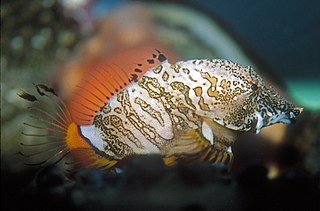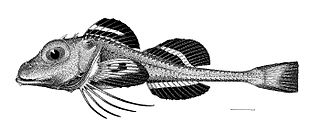
Rhamphocottus is a genus of marine ray-finned fishes belonging to the family Rhamphocottidae. These fishes are known as grunt sculpins. The grunt sculpins are found in the North Pacific Ocean.

Rhamphocottidae is a family of ray-finned fishes belonging to the superfamily Cottoidea, the sculpins. The species in this family occur in the North Pacific Ocean.

The Hemitripterinae is a subfamily of the scorpaeniform family Agonidae, known as sea ravens or sailfin sculpins. They are bottom-dwelling fish that feed on small invertebrates, found in the northwest Atlantic and north Pacific Oceans. They are covered in small spines.

The Pacific staghorn sculpin is a species of marine ray-finned fish belonging to the family Cottidae, the typical sculpins. This species is found in the eastern Pacific Ocean. It is the only species in the monospecific genus Lepidocottus.

Clinocottus globiceps, the mosshead sculpin or globe-headed sculpin, is a species of marine ray-finned fish belonging to the family Cottidae, the typical sculpins. This sculpin is found in the northeastern Pacific.

Clinocottus acuticeps, the sharpnose sculpin, is a species of marine ray-finned fish belonging to the family Cottidae, the typical sculpins. This sculpin is found in the eastern Pacific Ocean.

The roughback sculpin is a species of marine ray-finned fish belonging to the family Cottidae, the typical sculpins. This species is found in the eastern Pacific Ocean. The roughback sculpin is the only known member of the genus Chitonotus.

Trachidermus fasciatus is a species of fish in the superfamily Cottoidea, the sculpins, and the only member of the monotypic genus Trachidermus. Its common name is roughskin sculpin. It has also been called four-gilled perch. It is native to the coastlines of China, Japan, and Korea, where it occurs at the mouths of rivers.

Ereunias is a monotypic genus of marine ray-finned fish belonging to the family Rhamphocottidae, the grunt sculpins. Its only species is Ereunias grallator which is a bathydemersal species found at depths of around 500 m (1,600 ft) in the northwestern Pacific Ocean off Japan. This species attains a maximum published total length of 30 cm (12 in). This species was first formally described in 1901 by the American ichthyologists David Starr Jordan and John Otterbein Snyder from Misaki, Sagami in Japan. Jordan and Snyder proposed the new genus Ereunias for the new species. The genus name is derived from ereunao, meaning "to explore" which may refer how it uses elongated pectoral-fin rays as feelers or “feet” to explore the substrate; suffixed with ias which is used in some Greek names for fishes. The specific name grallator is "stiltwalker" in Latin and is an allusion to the elongated pectoral fin rays. Along with the genus Marukawichthys this taxon was classified in the family Ereunidae but this was synonymised with the Rhamphocottidae in 2014.

Blepsias is a genus of marine ray-finned fishes belonging to the family Agonidae, the poachers and related fishes. These fishes are found in the coastal northern Pacific Ocean from Japan to California.

Blepsias cirrhosus, the silverspotted sculpin, is a species of sculpin belonging to the subfamily Hemitripterinae of the family Agonidae. This species is found the northern Pacific Ocean from the Sea of Japan and Alaska to San Miguel Island off southern California.

Blepsias bilobus, the crested sculpin, is a species of sculpin belonging to the subfamily Hemitripterinae of the family Agonidae. This species is found in the North Pacific Ocean.

Enophrys bison, the buffalo sculpin, is a species of marine ray-finned fish, belonging to the family Cottidae, the typical sculpins. It is found in the eastern Pacific Ocean.

The bald sculpin is a species of marine ray-finned fish belonging to the family Cottidae, the typical sculpins. It is found in the eastern Pacific Ocean.

The butterfly sculpin is a species of fish in the family Agonidae. It is found in the North Pacific Ocean.
Zaniolepis frenata, also known as the shortspine combfish, is a species of ray-finned fish belonging to the family Zaniolepididae.The species occurs in the eastern Pacific Ocean.
Rhamphocottus nagaakii is a species of marine ray-finned fish belonging to the family Rhamphocottidae, the grunt sculpins. This species was first formally described in 2022 with its type locality given as off Minami-Sanriku cho in Miyagi Prefecture of Japan. It is thought to have evolved from a common ancestor to the grunt sculpin but the two species were thought to have been separated by a cooling event during either the Pliocene or Miocene. This species differs from the grunt sculpin genetically and morphologically. The specific name honours Nagaaki Satoh, a professional diving instructor, who was the first to observe the reproductive behaviour of R. nagaakii and passed these observations to the species' describers.

Hypsagoninae is a subfamily of marine ray-finned fishes belonging to the family Agonidae, part of the sculpin superfamily Cottoidea. These fishes are found in the North Pacific Ocean.

The Arctic staghorn sculpin is a species of marine ray-finned fish belonging to the family Cottidae, the typical sculpins. This sculpin is found in the Arctic Ocean and the northern Atlantic Ocean.

Clinocottus embryum, the calico sculpin or mossy sculpin, is a species of marine ray-finned fish belonging to the family Cottidae, the typical sculpins. It is found in the eastern Pacific Ocean.


















